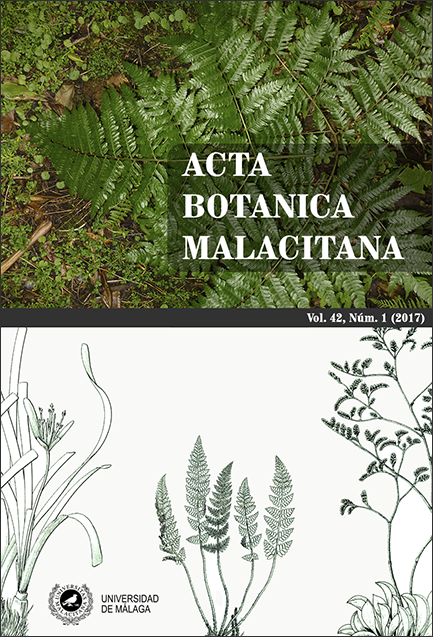Novedades en Jamesonia y Tryonia (Pteridaceae) para el Neotrópico.
DOI:
https://doi.org/10.24310/abm.v42i1.3027Abstract
Tres especies nuevas de Jamesonia Hook. & Grev. para el Neotrópico son descritas aquí: J. erecta A. Rojas, J. panamensis A. Rojas y J. retroflexa A. Rojas. La primera especie se caracteriza por rizoma robusto y ascendente; frondas cortas y ascendentes; lámina estrecha; rachis recto a levemente flexuoso, lámina adaxialmente glabra y abaxialmente con pelos glandulares. La segunda especie tiene distintivamente estípite atropurpúreo a negro, lustroso y glabro; lámina 1-pinnada-pinnatifida o hasta 2-pinadas basalmente, con base truncada; segmentos terminales con dientes agudos, pelos sobre la superficie abaxial rígidos e hialinos, y distribuidos a 1850-2200 m. La tercera especie es reconocida por la lámina oblonga; rachis pardo y flexuoso; pinnas ascendentes; pínnulas retroflexas; segmentos apicales que terminan en particiones ampliamente dicotómicas; venas terminado en puntas oscuras y distribuidas a mayor altitud (3500 m). En el género Tryonia Schuettp., J. Prado & A.T. Cochran se describe a T. macrophylla A. Rojas, y difiere de T. myriophylla (Sw.) Schuettp., J. Prado & A.T. Cochran. por rizoma y base del estípite escamosos; estípite y raquis pardo-rojizo; frondas largas (150-200 cm), conocidas de Colombia y distribuidas a mayor distribución altitudinal (2450- 2740 m). Seguidamente se combina a Gymnogramma glandulifera Hieron. bajo el género Jamesonia y se registra para Costa Rica y Mesoamérica a Jamesonia rufescens (Fée) Christenh.
Downloads
Metrics
References
Christenhusz, M.J.M., Zhang, X.C. & Schneider, H. (2011). A linear sequence of extant families and genera of lycophytes and ferns. Phytotaxa 19: 7–54. DOI: 10.11646/phytotaxa.19.1.2
Cochran, A.T., Prado, J. & Schuettpelz, E. (2014). Tryonia, a new taenitidoid fern genus segregated from Jamesonia and Eriosorus (Pteridaceae). PhytoKeys 35: 23–43. DOI: 10.3897/phytokeys.35.6886
Gómez, L.D. & Arbeláez, A.L. (2009). Flora de Nicaragua. Tomo IV: helechos. St. Louis, Missouri, USA: Missouri Botanical Garden.
Mickel, J.T. & Smith, A.R. (2004). The Pteridophytes of Mexico. Mem. New York Bot. Gard. 88: 1–1029.
Moran, R.C. (1995). Eriosorus. Pp. 130–131. In R. C. Moran & R. Riba (Eds.), Flora Mesoamericana. Volumen 1. Psilotaceae a Salviniaceae. Universidad Nacional Autónoma de México. Ciudad Universitaria, D.F., México.
Moran, R.C. (2002). The genera of neotropical ferns, a guide for students. Tropical Plant Systematics. Mimeografiado.
Moran, R.C. (2009). Géneros Neotropicales de helechos y licófitos. Una guía para estudiantes. Sistemática de Plantas Tropicales. San José, Costa Rica. Mimeografiado. 406 p.
Murillo, M.T., Murillo, J., León, A. & Triana, L.A. (2008). Los Pteridófitos de Colombia. Bogotá, DC: Arfo. 533 p.
Pavón, N. & González, F. (2016). Nephopteris out of the clouds: Molecular evidence places the enigmatic N. maxonii (Pteridaceae) within the Jamesonia clade. Brittonia 68 (1): 83–92. DOI: 10.1007/s12228-015-9394-0
Sánchez, P. (2004). Phylogenetics and Biogeography of the neotropical fern genera Jamesonia and Eriosorus (Pteridaceae). Amer. J. Bot. 91 (2): 274–284. DOI: 10.3732/ajb.91.2.274
Smith, A.R. (1995). Pteridophytes. In: P. E. Berry, B.K. Holst, and K. Yatskievych (Eds.). Flora of the Venezuelan Guayana. Volume 2. Pteridophytes, Spermatophytes: Acanthaceae-Araceae (pp. 1–327). Portland, Oregon, U.S.A: Timber Press.
Smith, A.R. (1995). Pteridophytes. In: P. E. Berry, B.K. Holst, and K. Yatskievych (Eds.). Flora of the Venezuelan Guayana. Volume 2. Pteridophytes, Spermatophytes: Acanthaceae-Araceae (pp. 1–327). Portland, Oregon, U.S.A: Timber Press.
Tryon, A.F. (1970). A Monograph of Eriosorus. Contr. Gray Herb. 200: 54–174.
Tryon, R.M. & Stolze, R. (1989). Pteridophyta of Peru. Part II. 13. Pteridaceae-15. Dennstaedtiaceae. Fieldiana Bot., n.s. 22: 94–122.
Downloads
Published
How to Cite
Issue
Section
License
All information related to the licensing of published works in Acta Botanica Malacitana and copyright can be found in our Editorial Policy.







1.png)
